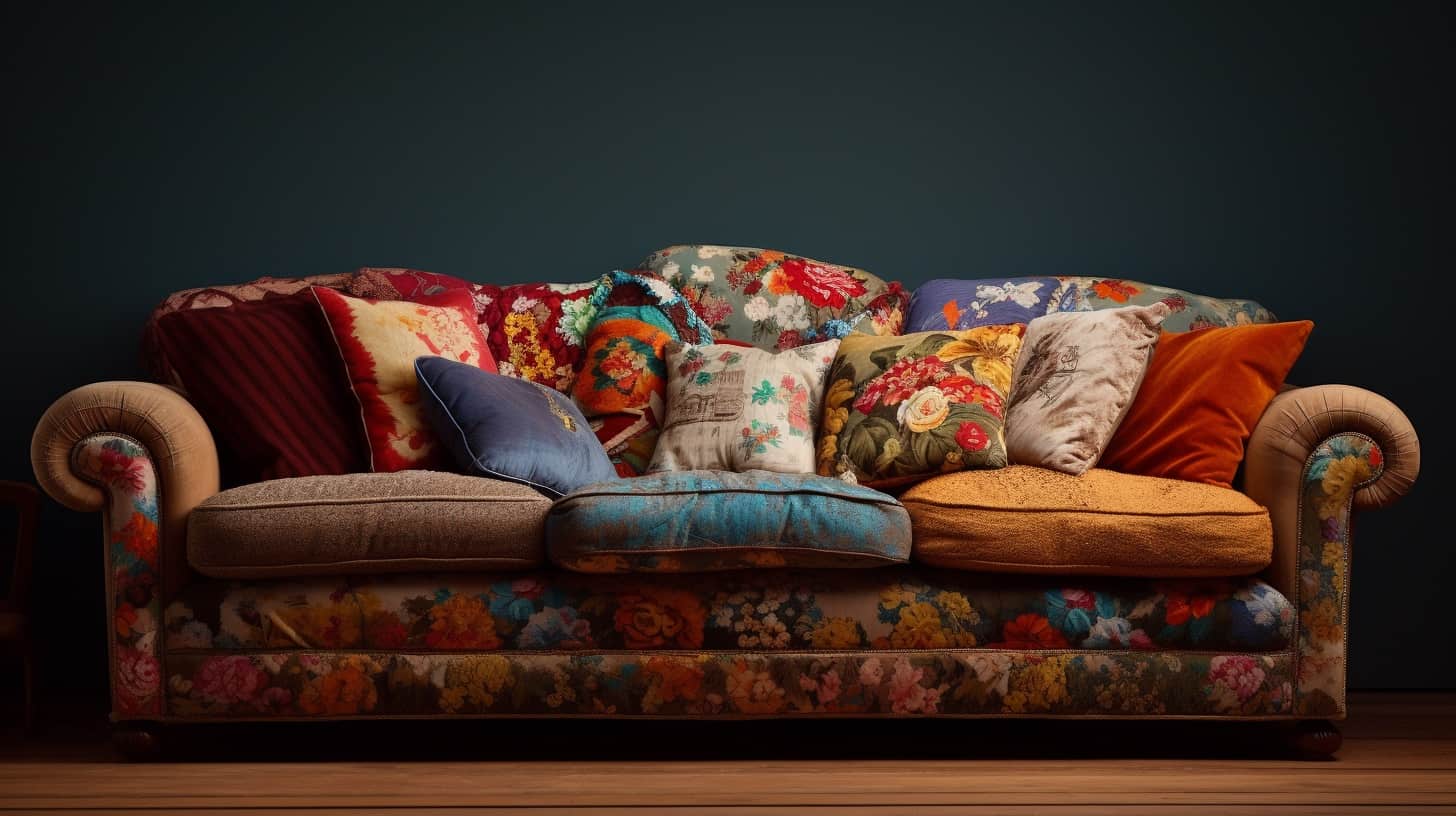Sofa looking a bit frumpy? Time for a DIY makeover! With a dash of creativity, a sprinkle of know-how, and a whole lot of elbow grease, you can reupholster your entire couch. Here’s everything you need to know about the process of reupholstering your sofa.
Can you reupholster a couch without sewing?
Technically you can reupholster a sofa without sewing, but we wouldn’t necessarily recommend it. But if you want a real vintage touch for your favorite mid century modern couch, then we won’t stop you! Here’s how it works.
- No-Sew Options: Yes, you can reupholster a couch without sewing! There are creative alternatives that allow you to give your couch a fresh look without picking up a needle such as screwing, tacking or stapling your fabric to the frame of the sofa or around cushions. Again, not the recommended approach but it might be suitable for certain situations!
- Fabric Draping: One approach is to drape and tuck fabric over the couch, securing it with fabric-friendly fasteners like pins, clips, or adhesive tape. This gives a loose, casual look and is perfect for a quick update.
- Stretch Slipcovers: Stretchy slipcovers are designed to fit snugly over your couch, providing a tailored look without the need for sewing. They come in various colors and styles to suit your taste.
- Fabric Wraps: Another option is using fabric wraps or bands to cover specific parts of the couch, like the arms or backrest. These wraps can be secured with ties or adhesive strips.
So, whether you’re draping, wrapping, or slipping on a stretchy cover, the world of no-sew couch reupholstery is full of creative possibilities.
Can you reupholster a couch over existing fabric?
If you don’t think you have the best couches, then reupholstering might be a savvy solution. But can you add new upholstery over existing fabric?
- Yes, You Can, But… : Reupholstering a couch over existing fabric is indeed a viable option, though it’s rarely the best choice. However, if you’d like to give it a shot, it can be a creative way to update the look of your couch without completely stripping it down.
- Assess the Condition: Before diving in, assess the condition of the existing fabric. Is it still in good shape? Is it clean and free of damage? If so, you might be able to build upon it.
- Thicker Fabrics: Thicker, textured fabrics can sometimes serve as a suitable base for reupholstering. They can help smoothen out imperfections and provide a solid foundation for the new fabric.
- Tightening and Tucking: Reupholstering over existing fabric often involves tightening and tucking the new fabric around the existing one. This can create a neat, layered effect and add extra padding.
- Consult a Professional: While reupholstering over existing fabric can be a DIY project, it’s a good idea to consult a professional if you’re unsure. They can offer guidance based on the condition of your couch.
- Fabric Compatibility: Choose the new fabric wisely. Opt for a fabric that complements the existing one in terms of texture, color, and pattern. This way, you’re creating a harmonious blend of styles.
So before you take that Pottery Barn couch behind the shed, consider whether you can save it with reupholstery.
Should I remove the old fabric before reupholstering?

Generally the standard reupholstery process involves removing all of the old fabric from the sofa. It’s not completely necessary, but it’s usually the recommendation. But if you’re not sure, here are some things to consider!
- Gauge Fabric Condition: Before making a decision, gauge the condition of the old fabric. Is it damaged, stained, or worn out? If it’s in poor shape, removal might be the way to go.
- Clean Slate: Stripping away the old fabric gives you a clean slate to work with. You can address any underlying issues, reshape padding, and ensure a fresh start for your couch.
- Quality Matters: If you’re reupholstering a valuable or antique piece, removal might be the better option. This ensures that the new fabric is properly secured and aligned.
- Layers of Charm: On the other hand, leaving the old fabric intact can add layers of charm and cushioning to your couch. It can also help preserve the couch’s original shape and padding.
- Economical Option: Reupholstering over the old fabric can be a cost-effective choice. It saves you from the labor-intensive process of removing every staple and piece of fabric.
- The Pros Know: Consider seeking professional advice based on your couch’s specific condition. A skilled upholsterer can provide insights on whether removal is necessary.
- Personal Preference: Ultimately, the decision depends on your preferences and goals for the reupholstering project. Whether you choose to reveal the bare bones or embrace the layers, it’s all about the vision you have for your couch.
So when life hands you lemons (or maybe just a pink sofa you hate), sometimes the best thing to do is make lemonade (or pink lemonade). Consider reupholstery!
What fabric is suitable to reupholster a couch?
The entire world of upholstery grade fabric is at your disposal! If it’s durable enough it can be used to reupholster your sofa. You can even use leather!
- Charming Chenille: Chenille is a soft, plush fabric that brings a touch of luxury. Its cozy texture adds warmth to your space, and it’s available in a variety of colors and patterns.
- Classic Canvas: Canvas is a durable and versatile choice, known for its sturdiness. It’s a blank canvas (pun intended!) for showcasing different textures and colors.
- Lovely Linen: Linen is a natural fabric that’s both breathable and elegant. It adds a relaxed, airy feel to your couch and comes in a range of neutral tones.
- Beautiful Velvet: Velvet oozes opulence and sophistication. Its luxurious texture catches the light and adds depth to your couch. It’s also a synthetic fabric made of polyester and has amazing cleanability and durability just like its microfiber partner below.
- Faux Leather: If you’re looking for a leather look without the price tag, faux leather is the way to go. It’s easy to clean and comes in various colors.
- Microfiber Marvels: Microfiber is known for its durability and resistance to stains. It’s a practical choice, especially for households with kids or pets.
Choosing the fabric you want to use for reupholstery is by far the most enjoyable part of the process. Cherish it and choose wisely!
Do you need a sewing machine to reupholster a couch?
What’s amazing is that you don’t need a sewing machine to reupholster a couch. But would we recommend you use one? Absolutely. It’ll make the whole process easier. But if you don’t have access to one or know how to use one, all hope is not lost. So we definitely recommend one if you have a tricky shape like a curved couch.
- Handy Without a Machine: Good news, you don’t necessarily need a sewing machine to reupholster a couch, though we’d strongly encourage it. While sewing machines can make the process quicker, you can definitely take a stab at reupholstering by hand.
- Needles and Threads: Basic hand sewing skills, like stitching and knotting, can go a long way. Invest in strong needles and durable threads that can handle the fabric and cushion materials.
- Upholstery Tacks and Glue: In place of sewing, you can use upholstery tacks or heavy-duty glue to secure fabric in certain areas. This can be particularly useful for attaching fabric to the frame or adding decorative elements.
- Staple It Up: Staple guns are often a reupholsterer’s best friend. They can effectively secure fabric to the couch frame without the need for sewing. Just be sure to use heavy-duty staples.
- Options Galore: If sewing isn’t your jam, there are creative alternatives to explore. From using fabric adhesive to Velcro strips, there’s a solution that suits your comfort level.
Reupholstering a couch is all about being resourceful and finding methods that work for you. While a sewing machine will definitely speed up the process, it’s not the only way to achieve fantastic results.
How to reupholster furniture yourself?
Wanting to flex those DIY muscles? Reupholstery is no joke, but it is a process that you can do yourself. But maybe start with a simple couch cushion and not that power reclining sofa in the basement.
- Gather Your Supplies: Arm yourself with the essentials—fabric, foam or padding, screwdrivers, pliers, staple gun, scissors, and any other tools specific to your furniture piece.
- Assess and Dismantle: Evaluate your furniture’s construction and take it apart, removing any existing fabric, padding, and staples carefully.
- Measure and Cut: Lay out your new fabric and measure, allowing extra for folding and stapling. Cut your fabric to fit the different sections of your furniture.
- Padding Perfection: If your furniture’s padding is worn out, replace it with new foam or batting. Trim it to fit neatly.
- Staple It Down: Begin stapling the fabric onto the furniture frame. Start from the center and work your way out, ensuring the fabric is taut and smooth.
- Corners and Curves: Corners and curves can be tricky. Create neat folds and pleats, securing them with staples.
- Trim and Finish: Trim excess fabric and make sure everything looks tidy and polished. Reattach any hardware that was removed.
- Buttons and Tufting: If your furniture has buttons or tufting, sew them in place before attaching the fabric.
- Embrace Imperfections: Remember, reupholstering is a skill that improves with practice. Embrace imperfections as part of the DIY journey.
- Stay Patient and Creative: DIY reupholstery can be challenging, but it’s also incredibly rewarding. Take your time, stay patient, and enjoy the creative process.
By taking on a DIY reupholstery challenge, you’re changing furniture into something that’s truly yours. It’s a chance to infuse your personal style and create a statement piece that stands out in any room.
Can you upholster over a leather sofa?
While we wouldn’t recommend upholstering over leather, it can be done! But be sure to read up on it first.
- Professional Help: Reupholstering over leather can be more challenging, so don’t hesitate to seek professional assistance if needed. Upholstery experts have the skills to tackle complex projects.
- Assessment: Evaluate the condition of your leather sofa. Reupholstering over leather can be more challenging due to its smooth surface, so ensure it’s a good candidate for the process.
- Choose the Right Fabric: Opt for a durable fabric that can adhere well to the leather. Fabrics with a bit of texture or grip tend to work better. Keep in mind that fabric adds thickness, so account for that in your measurements.
- Cleaning and Priming: Clean the leather thoroughly to remove any dirt or oils that might affect the fabric’s adherence. You might also need to apply a primer to create a suitable surface for the fabric.
- Padding and Layers: Depending on the condition of the leather and your desired outcome, you might need to add padding or layers between the leather and fabric. This helps achieve a smooth, even look.
- Stapling Technique: Stapling fabric over leather can be trickier than on a wooden frame. Use a staple gun designed for upholstery and make sure the fabric is taut and secure.
- Corners and Edges: Pay extra attention to corners, edges, and seams. You might need to fold and tuck the fabric carefully to ensure a neat finish.
- Finishing Touches: Once the fabric is in place, trim any excess and make sure everything looks polished. Buttons, tufting, and other decorative elements can add character to your reupholstered sofa.
And voila! A sofa that looks good as new. And now in fabric! It’s almost magic.

